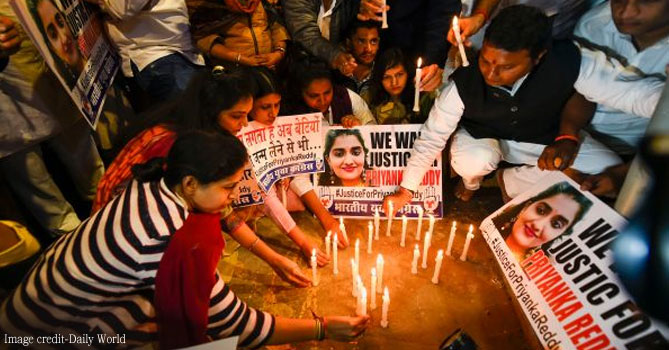
A few days back, India woke up to the disturbing news of a young vet doctor being brutally raped and murdered. Her body was burnt by the four accused and her charred body was discovered in the wee hours. I don’t know anyone from the last few days who haven’t talked about this ghastly incident. While all hell broke loose on social media, opinions started pouring in from every stratum of the society that India needs a speedy trial on such issues. One can only imagine the turmoil through which Nirbhaya’s parents have had to go through in attending court proceedings month after month.
However, today we woke up to the news of crackers being burst, sweets being distributed, and flower petals being showered at Hyderabad police with scenes of jubilation at the site of the ‘Encounter’. Slogans of “#JusticeDelivered” is reverberating across India after Hyderabad police killed all the four accused in a police encounter.
Apart from feeling elated for the poor family, my mind wandered along the road less taken on this matter. Why is our justice system selectively provoked? In Hyderabad, the police captured the four accused within twenty-four hours of the incident. The news of the encounter came in just a few days of the arrests. The encounter has turned the case into a short-lived trial and it has saved us from the optic of a long judicial process. One feels only a sense of elation but what about the other victims. A day before the news of the encounter broke, the Unnao rape case victim was attacked by five men of whom two were the main accused in the case. They attacked her, stabbed her and set her ablaze. The victim’s father had died in judicial custody and following a truck collision on 28 July 2019 that resulted in the serious injury of the victim and death of two relatives, it was revealed that the family had been threatened and had even written to the Chief Justice of India for help. And today, months later, the victim is struggling for her life from 90% burn.
Why were the accused given bail after such a heinous crime?
Why did her father die in judicial custody?
After proofs and circumstantial pieces of evidence, why hasn’t the police acted to the rescue of the victim’s family? Is it because the two prime accused are two politicians? Although, a second charge sheet was filed by the CBI on 13 July 2018 and accused Kuldeep Singh Sengar, his brother, three policemen and five other individuals of framing the Unnao rape survivor’s father as the perpetrator. There is yet any robust action to be taken up against them.
Observe how different the two situations are. The parameters are so different for the same crime. In this regard, we can only thank that the four accused in the Hyderabad rape and murder case were not some politicians or rich and powerful men.
But this celebration over the encounter brings into light some serious questions. As public rejoicing the act, will we be able to surrender our complete conviction to the system post this act also? Can we be assured of the fact that if the police have presumably crossed the line and taken law in their own hands, no policemen in the country will get into the abuse of power anywhere in the future for any other case?
Secondly, considering that by some act of providence that the rapists have been killed in the encounter out of their own accord, the roar of celebration echoing from across the country can be translated into an eccentric slap on the face of the judiciary. That the judicial system has completely failed in addressing such cases with speedy trials is stark clear from the joy common people are expressing even at such outright breaking of the law. This to me appears like a complete catharsis of the pent-up anger and frustration from the people and scores of victims and other women who have been able to relate with this incident with an empathetic joy all the more reflecting the vacuum of judicial prowess.
However, the question will remain how, as a society, we are going to move ahead. In India, matters seem to swing across the extreme ends of the pendulum. Even most of the rape perpetrators seem to either belong to the lower economic strata of the society – rag pickers, lorry drivers, bus drivers and conductors and the likes (although a rapist cannot be categorized under any society, profession, religion, race), or to the uppermost strata of the society such as the politicians and the rich. Evidently, with even the police addressing the same crime, we can apparently see how selectively they handle the perpetrators.





